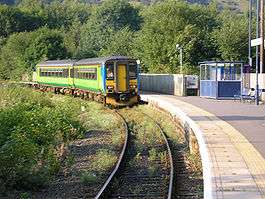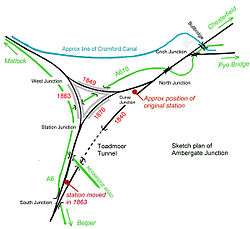Ambergate railway station
Ambergate railway station is a railway station owned by Network Rail and managed by East Midlands Railway. It serves the village of Ambergate in Derbyshire, England. The station is located on the Derwent Valley Line from Derby to Matlock, which diverges from the Midland Main Line just south of the station at Ambergate Junction.
| Ambergate | |
|---|---|
 Ambergate station seen in 2005 | |
| Location | |
| Place | Ambergate |
| Local authority | Borough of Amber Valley |
| Grid reference | SK348516 |
| Operations | |
| Station code | AMB |
| Managed by | East Midlands Railway |
| Number of platforms | 1 |
| DfT category | F2 |
| Live arrivals/departures, station information and onward connections from National Rail Enquiries | |
| Annual rail passenger usage* | |
| 2014/15 | |
| 2015/16 | |
| 2016/17 | |
| 2017/18 | |
| 2018/19 | |
| History | |
| 11 May 1840 | Station opens as Amber Gate |
| 1 October 1846 | Station renamed Ambergate |
| 1 June 1863 | Station moved 400m due south |
| 10 December 1876 | Station moved 605m due north |
| National Rail – UK railway stations | |
| |
Ambergate–Pye Bridge Line | ||||||||||||||||||||||||||||||||||||||||||||||||||||||||||||||||||||||||||||||||||||||||||||||||||||||||||||||||
|---|---|---|---|---|---|---|---|---|---|---|---|---|---|---|---|---|---|---|---|---|---|---|---|---|---|---|---|---|---|---|---|---|---|---|---|---|---|---|---|---|---|---|---|---|---|---|---|---|---|---|---|---|---|---|---|---|---|---|---|---|---|---|---|---|---|---|---|---|---|---|---|---|---|---|---|---|---|---|---|---|---|---|---|---|---|---|---|---|---|---|---|---|---|---|---|---|---|---|---|---|---|---|---|---|---|---|---|---|---|---|---|---|
| ||||||||||||||||||||||||||||||||||||||||||||||||||||||||||||||||||||||||||||||||||||||||||||||||||||||||||||||||

History
It has a complicated history. The original station was built for the North Midland Railway in 1840, between Derby and Leeds. It was an ornate building, by Francis Thompson,[1] which would have graced a Lord of the Manor.
From Belper the line ran along the Derwent Valley, along a stretch called Broadholme, with four bridges across the river, through Longlands Tunnel, across the River Derwent and Derby road with a magnificent five-arch viaduct. It then entered Hag Wood Tunnel as turned towards the Amber Valley.
The station building was just north of this tunnel. Shortly afterwards a proposal was made for an Ambergate, Nottingham, Boston and Eastern Junction Railway which however never materialised, apart from a stretch between Colwick and Grantham.
From Ambergate, towards Chesterfield, the next difficulty for the North Midland Railway was the intersection with the Cromford Canal, where the line intersected with the Bullbridge Aqueduct, before it carried on through a station at Wingfield to Stretton.
However, in 1849, the branch from Ambergate to Rowsley was built by the proposed Manchester, Buxton, Matlock and Midlands Junction Railway, with a west to north connection between the lines at the original Ambergate Junction. When a south to west connection was made, for trains from Derby to Rowsley, in 1863 the station building was rebuilt adjacent to the new Ambergate South junction. The original bridge was also widened at its northern end to accommodate the new junction.
In 1867 the Rowsley line had reached New Mills, which meant that the Midland Railway could operate from London to Manchester and Liverpool.
In 1875 Ambergate to Pye Bridge Line was opened from Crich Junction near Bullbridge which ran through Butterley to Pye Bridge, near Ironville on the Erewash Valley Line. Much of its business was coal traffic from Nottinghamshire to Manchester and Liverpool, avoiding Derby.
The triangular station
In 1876 a loop was built passing the west side of Hag Wood Tunnel, as a diversion from the original line to a third platform, which allowed for Derby to Sheffield stopping trains. The station was completely rebuilt, with the old building remaining in use a plans store. This third and final station was the famous triangular one, reputed to be one of only three in the country.
Throughout the late 19th and early 20th centuries, Ambergate was an important railway interchange with 28,207 tickets sold in 1872 rising to 90,157 by 1922.
In 1931 the line across Broadholme approaching from the south was upgraded to four tracks. Longlands Tunnel was opened up to form a wide cutting and the junction with the Manchester line was moved south of the river. A new modern steel bridge for the Manchester line was built alongside the original viaduct over the River Derwent and the A6 main road.
The line through Matlock, then the 'main line', carried London to Manchester expresses such as the Palatine and the Peaks. It also carried coal trains from Nottinghamshire, for a while with Garratt locomotives, which would be split at Rowsley for the long climb to Peak Forest.
Grouping and Nationalisation
Having gathered in the Midland Railway, the lines through the station became part of the London, Midland and Scottish Railway during the Grouping of 1923. The station then passed on to the London Midland Region of British Railways on nationalisation in 1948.
When Sectorisation was introduced in the 1980s, the station was served by Regional Railways until the Privatisation of British Railways.
Decline
The stopping service on the former North Midland route to Chesterfield & Sheffield (using the eastern platforms on the slow lines) was withdrawn in January 1967, when the other local stations on this section were closed. Most of the trackwork on the Derwent Valley line was lifted in 1968, soon after the closure of line from Rowsley to Buxton & Manchester whilst the line eastwards from Crich Junction to Butterley & Pye Bridge closed completely in December that year. The station buildings were removed in 1970. Although the triangular station site remained for a number of years, the road bridges were finally removed in the late 1980s. All that is left now is one platform on the surviving single track to Matlock, and the original main Derby to Sheffield line passing to the east through Hag Wood (Toadmoor) Tunnel and onwards to Clay Cross and Chesterfield. The original listing of Ambergate station for closure under the Beeching Axe led to its mention in the song "Slow Train" by Flanders and Swann.
Services
The station is served by East Midlands Railway with services formed using diesel multiple units of Classes 153, 156, or 158. The service operates from Newark Castle to Nottingham to Matlock via Derby. For journeys beginning at Ambergate, from 15 January 2015 tickets (for destinations anywhere on the railway network) may be obtained from a machine located in the waiting shelter on platform 1. Journey time to Derby is approximately 16 minutes. Services are hourly each way Monday to Saturday and two-hourly on Sundays.[2]
| Preceding station | Following station | |||
|---|---|---|---|---|
| East Midlands Railway Derwent Valley Line | ||||
| Disused railways | ||||
| Terminus | Midland Railway Ambergate to Pye Bridge Line | Line closed, station open |
||
References
- Pevsner, Nikolaus; Williamson, Elizabeth (1979). The Buildings of England. Derbyshire. Penguin Books. p. 58. ISBN 0140710086.
- GB eNRT 2015-16 Edition, Table 56 (Network Rail)
- Pixton, B., (2000) North Midland: Portrait of a Famous Route, Chelteham: Runpast Publishing
- Butt, R. V. J. (1995). The Directory of Railway Stations: details every public and private passenger station, halt, platform and stopping place, past and present (1st ed.). Sparkford: Patrick Stephens Ltd. ISBN 978-1-85260-508-7. OCLC 60251199.
- Jowett, Alan (2000). Jowett's Nationalised Railway Atlas (1st ed.). Penryn, Cornwall: Atlantic Transport Publishers. ISBN 978-0-906899-99-1. OCLC 228266687.
- Station on navigable O.S. map
External links
| Wikimedia Commons has media related to Ambergate railway station. |
- Train times and station information for Ambergate railway station from National Rail
- Map of the station in 1887 showing the triangular layout
- "Picture the Past" Original station building at Ambergate
- "Picture the Past" Triangular Station circa 1910
- "Picture the Past" View of the station
- Friends of the Derwent Valley Line
- Peak Rail
- Derwent Valley Line East Midlands Trains Community Rail Partnership